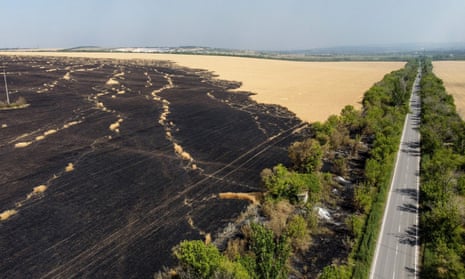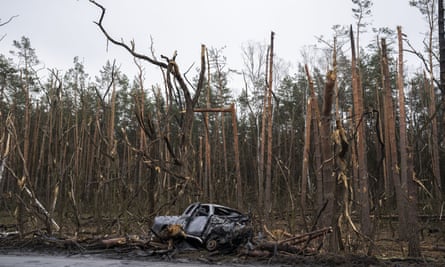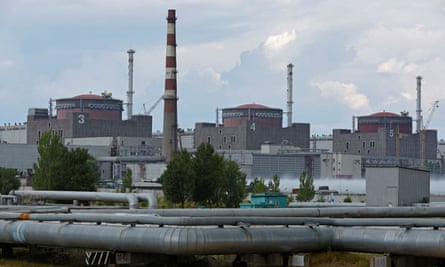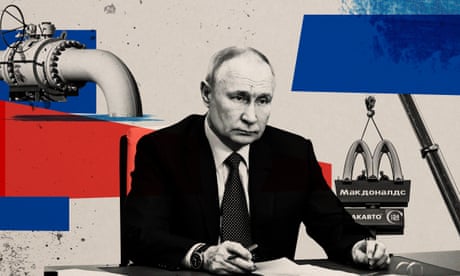The ‘silent victim’: Ukraine counts war’s cost for nature

Wheat plantations burnt after Russian airstrikes in Donetsk oblast.
Photograph: Miguel Medina/AFP/Getty Images
A year of war in UkraineUkraine
Investigations are under way in the hope this is the first conflict in which a full reckoning is made of environmental crimesRussia-Ukraine war – latest news updates
Please support our independent reporting today, from as little as £1/$1. It only takes a minute, and it makes a huge difference to what we do.
Jonathan Watts
A year of war in UkraineUkraine
Investigations are under way in the hope this is the first conflict in which a full reckoning is made of environmental crimesRussia-Ukraine war – latest news updates
Please support our independent reporting today, from as little as £1/$1. It only takes a minute, and it makes a huge difference to what we do.
Jonathan Watts
Global environment editor
THE GUARDIAN
Mon 20 Feb 2023
Toxic smoke, contaminated rivers, poisoned soil, trees reduced to charred stumps, nature reserves pocked with craters: the environmental toll from Russia’s war with Ukraine, which has been detailed in a new map, might once have been considered incalculable.
But extensive investigations by Ukrainian scientists, conservationists, bureaucrats and lawyers are now under way to ensure this is the first conflict in which a full reckoning is made of environmental crimes, so the aggressor can be held to account for a compensation claim that currently stands at more than $50bn (£42bn).
The environment ministry has set up a hotline for citizens to report cases of Russian “ecocide”, which so far number 2,303, and issues weekly updates of the tally. The latest edition estimates that in the past year:
Ukraine has had to absorb or neutralise the impact of 320,104 explosive devices.
Almost one-third of the country (174,000 sq km) remains potentially dangerous.
Debris includes 230,000 tonnes of scrap metal from 3,000 destroyed Russian tanks and other military equipment.
A hundred and sixty nature reserves, 16 wetlands and two biospheres are under threat of destruction.
A “large” number of mines in the Black Sea threaten shipping and marine animals.
Six hundred species of animals and 880 species of plants are under threat of extinction.
A third of Ukrainian land is uncultivated or unavailable for agriculture.
Up to 40% of arable land is not available for cultivation
Altogether the losses from land, water and air pollution amounted to $51.4bn, estimated Oleksandr Stavniychuk, the deputy head of the department of environmental control and methodology, at a recent workshop in Kyiv.
In part, this is effective wartime propaganda. At a time of heightened climate sensibilities, the Ukrainian government knows it can win hearts and minds by reminding the outside world that it is an environmentally conscious, food-producing, forward-thinking democracy that has been defiled by a fossil-fuel dictatorship that pays as little respect to nature as it does to the sovereignty of its neighbours.
But the implications of opening this new environmental-legal front are further reaching. It is also part of a broader and very modern battle that aims to tap scientific research, information technology, communication strategies and groundbreaking lawsuits in a way that puts a higher value on nature than most nations have recognised until now.
It is almost certainly the most detailed tally of wartime environmental destruction ever undertaken. During the Vietnam war, there was an outcry over the use of Agent Orange defoliants. In the Gulf war, considerable attention was focused on the burning of oil wells. But there has been nothing with the same range and ambition as the hotchpotch assessments now under way by civil society, universities and the government.
Those involved in this collective intelligence operation would not normally be classified as combatants, but much of their work requires considerable courage.

Toxic smoke, contaminated rivers, poisoned soil, trees reduced to charred stumps, nature reserves pocked with craters: the environmental toll from Russia’s war with Ukraine, which has been detailed in a new map, might once have been considered incalculable.
But extensive investigations by Ukrainian scientists, conservationists, bureaucrats and lawyers are now under way to ensure this is the first conflict in which a full reckoning is made of environmental crimes, so the aggressor can be held to account for a compensation claim that currently stands at more than $50bn (£42bn).
The environment ministry has set up a hotline for citizens to report cases of Russian “ecocide”, which so far number 2,303, and issues weekly updates of the tally. The latest edition estimates that in the past year:
Ukraine has had to absorb or neutralise the impact of 320,104 explosive devices.
Almost one-third of the country (174,000 sq km) remains potentially dangerous.
Debris includes 230,000 tonnes of scrap metal from 3,000 destroyed Russian tanks and other military equipment.
A hundred and sixty nature reserves, 16 wetlands and two biospheres are under threat of destruction.
A “large” number of mines in the Black Sea threaten shipping and marine animals.
Six hundred species of animals and 880 species of plants are under threat of extinction.
A third of Ukrainian land is uncultivated or unavailable for agriculture.
Up to 40% of arable land is not available for cultivation
Altogether the losses from land, water and air pollution amounted to $51.4bn, estimated Oleksandr Stavniychuk, the deputy head of the department of environmental control and methodology, at a recent workshop in Kyiv.
In part, this is effective wartime propaganda. At a time of heightened climate sensibilities, the Ukrainian government knows it can win hearts and minds by reminding the outside world that it is an environmentally conscious, food-producing, forward-thinking democracy that has been defiled by a fossil-fuel dictatorship that pays as little respect to nature as it does to the sovereignty of its neighbours.
But the implications of opening this new environmental-legal front are further reaching. It is also part of a broader and very modern battle that aims to tap scientific research, information technology, communication strategies and groundbreaking lawsuits in a way that puts a higher value on nature than most nations have recognised until now.
It is almost certainly the most detailed tally of wartime environmental destruction ever undertaken. During the Vietnam war, there was an outcry over the use of Agent Orange defoliants. In the Gulf war, considerable attention was focused on the burning of oil wells. But there has been nothing with the same range and ambition as the hotchpotch assessments now under way by civil society, universities and the government.
Those involved in this collective intelligence operation would not normally be classified as combatants, but much of their work requires considerable courage.

The gutted remains of a car in front of damaged trees following a battle between Russia and Ukrainian forces on the outskirts of Chernihiv in April 2022.
Photograph: Petros Giannakouris/AP
Kateryna Polyanska is a young landscape ecologist who travels the country, taking samples from bomb craters and photographs of environmental damage in national parks. This requires trips close to conflict zones and areas that have not yet been cleared of unexploded ordnance. The dangers are very real. On one trip, she came across a fox that had been killed by a mine. On another, she could hear the sound of nearby shelling. But she feels the risk is worth taking.
“Last year, I started doing this investigation by computer using only satellite images, but I decided I needed to see it with my own eyes,” she said. “War is not just about direct impacts, it is also the destruction of our nature and environment.”
At first, she was afraid to enter the craters, some of which are more than 3 metres deep. But after she had done 20, she jokes that she became a crater connoisseur.
The samples are sent back to a laboratory where they are tested for toxic chemicals, such as white phosphorus. This is necessary to decide how to rehabilitate the land and whether to advise local people to avoid potentially contaminated streams.
Kateryna Polyanska is a young landscape ecologist who travels the country, taking samples from bomb craters and photographs of environmental damage in national parks. This requires trips close to conflict zones and areas that have not yet been cleared of unexploded ordnance. The dangers are very real. On one trip, she came across a fox that had been killed by a mine. On another, she could hear the sound of nearby shelling. But she feels the risk is worth taking.
“Last year, I started doing this investigation by computer using only satellite images, but I decided I needed to see it with my own eyes,” she said. “War is not just about direct impacts, it is also the destruction of our nature and environment.”
At first, she was afraid to enter the craters, some of which are more than 3 metres deep. But after she had done 20, she jokes that she became a crater connoisseur.
The samples are sent back to a laboratory where they are tested for toxic chemicals, such as white phosphorus. This is necessary to decide how to rehabilitate the land and whether to advise local people to avoid potentially contaminated streams.
The environmental cost of the war in Ukraine
Hotspots among the thousands of ecological crimes reported since Russia’s invasion
Black Sea
200 mile
Some areas, she said, were charred, while others looked like moon landscapes. Among the most shocking environmental destruction was the bombing of ancient chalk slopes, a unique ecosystem in the Holy Mountain national park. “When you see craters there, you know it will never recover. The chalk slopes were formed over 100m years and then destroyed in one year of war.”
The worst damage is not always visible. “It is not just the explosive material, it is rocket fuel and shrapnel and wire … All these little tiny pieces of pollution have a huge impact on nature. You can’t imagine the scale of the impact.”
Most of her work focuses on assessing damage and potential hazards for people and nature. But rehabilitation and recompense play a part too.
Polyanska works for the Environmental People Law organisation, which brings together scientists and lawyers. They – like other civil society and government bodies in Ukraine – are building legal cases against Russia in the international criminal court under article eight of the Rome statute, which covers ecological crimes. In addition, the Geneva convention forbids “methods or means of warfare that are intended to cause or may be expected to cause widespread, lasting and severe damage to the natural environment”.
Some legal scholars and environmentalists hope Ukraine can push international law a step further by securing recognition of “ecocide” for crimes against the living natural world. This term, popularised by the British environmental lawyer Polly Higgins, has not yet been defined in international law, but Ukraine is one of several former Soviet bloc countries that have passed ecocide legislation. This is already being used. The prosecutor general’s office is processing 11 criminal proceedings under article 441 on ecocide of the criminal code of Ukraine. In November the president of Ukraine, Volodymyr Zelenskiy, told the G20 summit that the recognition of ecocide and the protection of the environment were among 10 key proposals in the Ukrainian formula for peace.
Independent of the government, conservation groups have mobilised and repurposed themselves to gather evidence. Ukraine’s biggest environmental NGO, Ecoaction has collated reports of more than 840 incidents and collaborated with Greenpeace to plot them on an interactive “environmental damage map”. Using satellite images, they have measured and highlighted the biggest physical impacts.
Among them are the attacks on industrial centres such as Odesa, Donetsk and Lviv, which released billowing clouds of benzopyrene, carbon monoxide, nitrogen oxides, and other toxic chemicals. War has also sparked vast forest fires, particularly in the Luhansk oblast, where 17,000 hectares of forest have been charred.
The worst damage is not always visible. “It is not just the explosive material, it is rocket fuel and shrapnel and wire … All these little tiny pieces of pollution have a huge impact on nature. You can’t imagine the scale of the impact.”
Most of her work focuses on assessing damage and potential hazards for people and nature. But rehabilitation and recompense play a part too.
Polyanska works for the Environmental People Law organisation, which brings together scientists and lawyers. They – like other civil society and government bodies in Ukraine – are building legal cases against Russia in the international criminal court under article eight of the Rome statute, which covers ecological crimes. In addition, the Geneva convention forbids “methods or means of warfare that are intended to cause or may be expected to cause widespread, lasting and severe damage to the natural environment”.
Some legal scholars and environmentalists hope Ukraine can push international law a step further by securing recognition of “ecocide” for crimes against the living natural world. This term, popularised by the British environmental lawyer Polly Higgins, has not yet been defined in international law, but Ukraine is one of several former Soviet bloc countries that have passed ecocide legislation. This is already being used. The prosecutor general’s office is processing 11 criminal proceedings under article 441 on ecocide of the criminal code of Ukraine. In November the president of Ukraine, Volodymyr Zelenskiy, told the G20 summit that the recognition of ecocide and the protection of the environment were among 10 key proposals in the Ukrainian formula for peace.
Independent of the government, conservation groups have mobilised and repurposed themselves to gather evidence. Ukraine’s biggest environmental NGO, Ecoaction has collated reports of more than 840 incidents and collaborated with Greenpeace to plot them on an interactive “environmental damage map”. Using satellite images, they have measured and highlighted the biggest physical impacts.
Among them are the attacks on industrial centres such as Odesa, Donetsk and Lviv, which released billowing clouds of benzopyrene, carbon monoxide, nitrogen oxides, and other toxic chemicals. War has also sparked vast forest fires, particularly in the Luhansk oblast, where 17,000 hectares of forest have been charred.

The Zaporizhzhia nuclear power plant.
Photograph: Alexander Ermochenko/Reuters
Of greatest concern, for humans at least, is Europe’s biggest nuclear plant at Zaporizhzhia, which has suffered fires, damage to power lines and now faces a threat to its cooling system from the low water levels in the Kakhovka reservoir which is controlled by Russia. Both sides have caused damage to water systems, but Russia was the initial aggressor and has gone much further in targeting industrial facilities and residential areas.
Yuliia Ovchynnykova, a Ukrainian MP who serves on a parliamentary environment committee, has launched an appeal for international recognition of Russia’s environmental crimes, which led to the Council of Europe adopting documents on ecocide. She is looking for more support from overseas lawmakers.
She says more than 2m hectares of forest have been destroyed, wrecking ecosystems and putting at risk rare endemic species such as pearl cornflowers, which can be found only on sandy steppes on the outskirts of Mykolaiv, or the bare tree, which is grows in a narrow area of the Stone Graves reserve in Donetsk. The war, she said, had made people realise the value of nature in a new way. As well as providing ecosystem services such as fresh water, clean air and fertile soil, Ovchynnykova said the country had a greater appreciation of the security benefits of places such as the Polissia – Europe’s largest holdout of wild nature – which is a natural protective barrier of hundreds of thousands of square kilometres of forests, swamps, floodplains, lakes and wet meadows. Similarly, when Russian troops attacked Kyiv early in the war, the detonation of a dam on the Irpin River created a swamp barrier against their advance.
Other impacts are indirect. In both countries, industry and agriculture lobbyists are using the crisis to push for looser protections for nature and open up more land for development. Manufacturing of missiles and other weapons causes pollution and emits carbon dioxide, as do the explosions and fire they ignite. The war is so far responsible for 33m tonnes of CO2 and postwar reconstruction is estimated to generate another 48.7m tonnes.

The sanctions war against Russia: a year of playing cat and mouse
This belies the oft-stated idea that nature benefits from humanity’s misfortune. That may have been true in the past in isolated no-go areas – wildlife has flourished in the heavily-mined demilitarised zone between North and South Korea, and – until the Ukraine war started – the contamination zone around the site of the Chornobyl nuclear disaster. But there is no such upside in a hot conflict. Even Chornobyl’s former sanctuary status has been eroded. Russian troops dug trenches in the locale, raising concerns that they might have unearthed radioactive soil.
Most abuses of nature go unreported in the media. “Nature is suffering. The environment is the silent victim of the war,” said Olena Maslyukivska, an environmental economist. As a member of a working group to calculate compensation, she is trying to address this and believes a restoration tax should be levied on Russian oil or Russian oligarchs as part of any peace deal.
Of greatest concern, for humans at least, is Europe’s biggest nuclear plant at Zaporizhzhia, which has suffered fires, damage to power lines and now faces a threat to its cooling system from the low water levels in the Kakhovka reservoir which is controlled by Russia. Both sides have caused damage to water systems, but Russia was the initial aggressor and has gone much further in targeting industrial facilities and residential areas.
Yuliia Ovchynnykova, a Ukrainian MP who serves on a parliamentary environment committee, has launched an appeal for international recognition of Russia’s environmental crimes, which led to the Council of Europe adopting documents on ecocide. She is looking for more support from overseas lawmakers.
She says more than 2m hectares of forest have been destroyed, wrecking ecosystems and putting at risk rare endemic species such as pearl cornflowers, which can be found only on sandy steppes on the outskirts of Mykolaiv, or the bare tree, which is grows in a narrow area of the Stone Graves reserve in Donetsk. The war, she said, had made people realise the value of nature in a new way. As well as providing ecosystem services such as fresh water, clean air and fertile soil, Ovchynnykova said the country had a greater appreciation of the security benefits of places such as the Polissia – Europe’s largest holdout of wild nature – which is a natural protective barrier of hundreds of thousands of square kilometres of forests, swamps, floodplains, lakes and wet meadows. Similarly, when Russian troops attacked Kyiv early in the war, the detonation of a dam on the Irpin River created a swamp barrier against their advance.
Other impacts are indirect. In both countries, industry and agriculture lobbyists are using the crisis to push for looser protections for nature and open up more land for development. Manufacturing of missiles and other weapons causes pollution and emits carbon dioxide, as do the explosions and fire they ignite. The war is so far responsible for 33m tonnes of CO2 and postwar reconstruction is estimated to generate another 48.7m tonnes.

The sanctions war against Russia: a year of playing cat and mouse
This belies the oft-stated idea that nature benefits from humanity’s misfortune. That may have been true in the past in isolated no-go areas – wildlife has flourished in the heavily-mined demilitarised zone between North and South Korea, and – until the Ukraine war started – the contamination zone around the site of the Chornobyl nuclear disaster. But there is no such upside in a hot conflict. Even Chornobyl’s former sanctuary status has been eroded. Russian troops dug trenches in the locale, raising concerns that they might have unearthed radioactive soil.
Most abuses of nature go unreported in the media. “Nature is suffering. The environment is the silent victim of the war,” said Olena Maslyukivska, an environmental economist. As a member of a working group to calculate compensation, she is trying to address this and believes a restoration tax should be levied on Russian oil or Russian oligarchs as part of any peace deal.

Kateryna Polyanska collects a soil sample from a bomb crater.
Photograph: Misha Lubarsky/The Observer
For now though, the fighting, burning and polluting continue, as does the effort to measure the horror. The researcher Polyanska plans to get back on the road in spring, after the winter snows have thawed. When the war is finally over, she hopes reconstruction can be used to improve as well as restore Ukraine. “I hope we can do things in a more ecological way. We need more green technology in industrial centres and perhaps there are some dams that we shouldn’t rebuild. We need deep scientific study.”
Other campaigners are also looking forwards. Denys Tsutsaiev of Greenpeace said Ukraine needed mechanisms and resources for nature restoration: “It’s an essential part of improving the health of people who suffer from the war and getting back to normal life.”
For now though, the fighting, burning and polluting continue, as does the effort to measure the horror. The researcher Polyanska plans to get back on the road in spring, after the winter snows have thawed. When the war is finally over, she hopes reconstruction can be used to improve as well as restore Ukraine. “I hope we can do things in a more ecological way. We need more green technology in industrial centres and perhaps there are some dams that we shouldn’t rebuild. We need deep scientific study.”
Other campaigners are also looking forwards. Denys Tsutsaiev of Greenpeace said Ukraine needed mechanisms and resources for nature restoration: “It’s an essential part of improving the health of people who suffer from the war and getting back to normal life.”
No comments:
Post a Comment